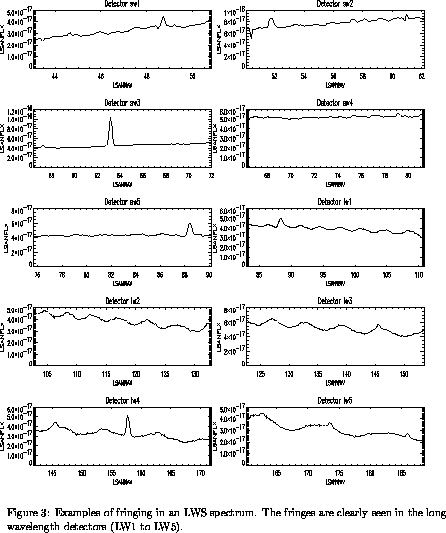



Next: Cookery Book
Up: Performance of the
Previous: Beam Width
LWS spectra of off-axis point sources or of extended sources show fringing.
In wave-
number space, these fringes are cosinusoidal with a fixed phase and a constant
period
of 3.6 cm , independent of the detector channel. This leads us to
suppose
that they arise from within the instrument and are caused by the interference
of two
beams arriving at the detectors along paths which have a fixed difference in
length.
Some examples of fringing are show in figure 3.
, independent of the detector channel. This leads us to
suppose
that they arise from within the instrument and are caused by the interference
of two
beams arriving at the detectors along paths which have a fixed difference in
length.
Some examples of fringing are show in figure 3.

If our interpretation of the origin of fringing is correct, the output
spectrum  of a single extended or off-centre source is a
modulation of the input spectrum
of a single extended or off-centre source is a
modulation of the input spectrum  :
:

where  is a function of the extent of the source or the amount by
which it is off-axis, and
is a function of the extent of the source or the amount by
which it is off-axis, and  is unity. The process of de-fringing
consists of estimating the modulating term and dividing the observed
spectrum by it. A more complicated case consists of a point (or very modestly
extended) source with spectrum
is unity. The process of de-fringing
consists of estimating the modulating term and dividing the observed
spectrum by it. A more complicated case consists of a point (or very modestly
extended) source with spectrum  embedded in a field of
extended emission with spectrum
embedded in a field of
extended emission with spectrum  . In this case, the
output spectrum is of the form:
. In this case, the
output spectrum is of the form:

In ths case, although there are fringes in the spectrum, the spectrum
of the source of interest is not itself intrinsically fringed. The
procedure for de-fringing in this case is to subtract the
spectrum of the extended source, estimated from the off-source
measurement. More generally, it may be possible to subtract the off-source
spectrum and then remove remaining fringes intrinsic to the source of
interest.
At the shortest wavelengths, the period of the fringe in wavelength
space is comparable with the grating resolution element, making the
detection of lines more difficult. Fringing of significant amplitude
in these detectors only occurs in the case of bright sources off
axis, however.
Note that the effect of fringing is present in both grating and
Fabry-Perot spectra of extended or off-axis sources.




Next: Cookery Book
Up: Performance of the
Previous: Beam Width
N.R. Trams, P.E. Clegg and B.M. Swinyard
Wed Aug 7 11:47:53 MET DST 1996
 , independent of the detector channel. This leads us to
suppose
that they arise from within the instrument and are caused by the interference
of two
beams arriving at the detectors along paths which have a fixed difference in
length.
Some examples of fringing are show in figure 3.
, independent of the detector channel. This leads us to
suppose
that they arise from within the instrument and are caused by the interference
of two
beams arriving at the detectors along paths which have a fixed difference in
length.
Some examples of fringing are show in figure 3.





 of a single extended or off-centre source is a
modulation of the input spectrum
of a single extended or off-centre source is a
modulation of the input spectrum  :
:

 is a function of the extent of the source or the amount by
which it is off-axis, and
is a function of the extent of the source or the amount by
which it is off-axis, and  is unity. The process of de-fringing
consists of estimating the modulating term and dividing the observed
spectrum by it. A more complicated case consists of a point (or very modestly
extended) source with spectrum
is unity. The process of de-fringing
consists of estimating the modulating term and dividing the observed
spectrum by it. A more complicated case consists of a point (or very modestly
extended) source with spectrum  embedded in a field of
extended emission with spectrum
embedded in a field of
extended emission with spectrum  . In this case, the
output spectrum is of the form:
. In this case, the
output spectrum is of the form:
